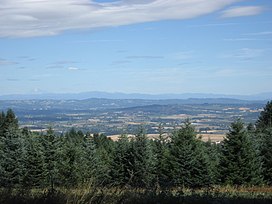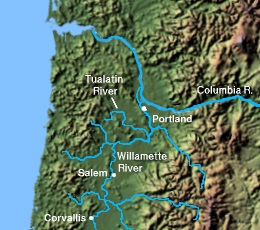Tualatin Valley
| Tualatin Valley | |
|---|---|
 The Tualatin Valley from Bald Peak State Scenic Viewpoint | |
 The Tualatin River | |
| Floor elevation | 180 ft (55 m) |
| Geography | |
| Location | Washington County & Clackamas County, Oregon |
| Borders on |
|
| Coordinates | 45°30′38″N 122°59′19″W / 45.51056°N 122.98861°W |
| Coordinates[1] | |
The Tualatin Valley is a farming and suburban region southwest of Portland, Oregon. The valley is formed by the meandering Tualatin River, a tributary of the Willamette River at the northwest corner of the Willamette Valley, east of the Northern Oregon Coast Range. Most of the valley is located within Washington County, separated from Portland by the Tualatin Mountains. Communities in the Tualatin Valley include Banks, Forest Grove, Cornelius, Hillsboro, Aloha, Beaverton, Sherwood, Tigard, and Tualatin.
History
In the early 19th century, the valley was inhabited by the
The valley was one of the earliest settled farming regions in Oregon, as settlers began arriving in 1840.
The lack of roads connecting the upper valley to the Willamette River quickly became a hindrance to early settlers. In 1850, the
The growth of agriculture in the valley was eventually limited in the middle 20th century by the need for irrigation.[3] In 1966, the United States Bureau of Reclamation built the Tualatin Project, bringing additional water to many parts of the valley in the last federal reclamation project in the Pacific Northwest.[3]

In the second half of the 20th century the valley became increasingly suburbanized and now forms a distinct cultural area that rivals Portland itself in political and economic influence. The communities along the
Tualatin Valley sits at the northwestern edge of the Willamette Valley, known for its production of wine, especially Pinot noir. Established in 1970 in Tualatin Valley, Ponzi Vineyards was among the first Oregon wineries to produce estate-grown Pinot Noir. Its 130 acres of family-owned vineyards are LIVE Certified Sustainable and it is one of the largest wineries in Oregon. As of June 3, 2020, Ponzi Vineyards is located within the Laurelwood District AVA which was approved by the Alcohol and Tobacco Tax and Trade Bureau (TTB). The Tualatin Hills AVA was also approved at the same time in 2020. The two AVAs share a small portion of their boundaries and contain among the highest concentrations of Laurelwood soils in the state.
Geography
The valley is traversed by the
Attractions
- Tualatin River National Wildlife Refuge
- L.L. Stub Stewart State Park
- Scoggins Valley Park & Henry Hagg Lake
- Jackson Bottom Wetlands Preserve
- Rice Northwest Museum of Rocks and Minerals
See also
References
- ^ a b "Tualatin Valley". Geographic Names Information System. United States Geological Survey, United States Department of the Interior. 2006-03-03. Retrieved 2009-11-15.
- ^ OCLC 4874569.
- ^ a b "Irrigation Water in Oregon's Green Willamette Valley Tualatin Project, Oregon". Tualatin Valley Irrigation District. Retrieved 2009-11-15.
- ^ Mapes, Jeff (September 13, 1998). "Gore walks tight line on Clinton". The Oregonian.
